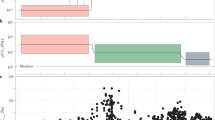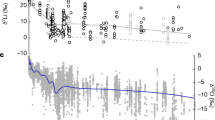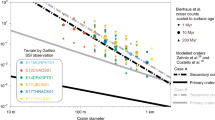Abstract
Tabulations1–4 of the number of genera present before and after the Cretaceous–Tertiary extinctions have revealed certain patterns1–6. Marine organisms were much more susceptible to extinction than were freshwater or terrestrial organisms. Benthic marine organisms were affected as much as those organisms that swam or floated. However, some marine genera were unaffected whilst some terrestrial ones were severely affected. Organisms making calcium-containing skeletons were the most sensitive. Among the hypotheses2,5–9 proposed for the extinctions is that they were caused by ionizing radiations2,8,9. The hypothesis proposed here is that the pattern of extinction in the fossil record emerged as a consequence of neutron activation of certain elements in organisms and in their environment.
This is a preview of subscription content, access via your institution
Access options
Subscribe to this journal
Receive 51 print issues and online access
$199.00 per year
only $3.90 per issue
Buy this article
- Purchase on Springer Link
- Instant access to full article PDF
Prices may be subject to local taxes which are calculated during checkout
Similar content being viewed by others
References
Russell, D. A. Scient. Am. 246, 58–65 (1982).
Russell, D. A. A. Rev. Earth planet. Sci. 7, 163–182 (1979).
Russell, D. A. Syllogeus 12, 11–23 (1977).
Russell, D. A. & Rice, G. (eds) K-TEC II: Cretaceous–Tertiary Extinctions and Possible Terrestrial and Extraterrestrial Causes (Syllogeous Ser. No. 39, National Museums of Canada, Ottawa, 1982).
Emiliani, C., Kraus, E. B. & Shoemaker, E. M. Earth planet. Sci. Lett. 55, 317–334 (1981).
Hsu, K. J. Nature 285, 201–203 (1980).
Schindewolf, O. H. Z. dt. geol. Ges. 114, 430–445 (1962).
Terry, K. D. & Tucker, W. H. Science 159, 421–423 (1968).
Tobias, C. A. & Todd, P. in Space Radiation Biology and Related Topics, 197–255 (Academic, New York, 1974).
Ashton, F. in Cosmic Rays at Ground Level (ed. Wolfendale, A. W.) 75–83 (Institute of Physics, London, 1973).
Olsson, I. U. (ed.) Radiocarbon Variations and Absolute Chronology (Wiley, New York, 1970).
Lal, D. & Peters, B. Encyclopedia of Physics Vol. XLVI/2, 551–611 (Springer, New York, 1967).
Hess, V. F. & Eugster, J. Cosmic Radiation and Its Biological Effects (Fordham University Press, New York, 1949).
Hess, W. N., Canfield, E. H. & Lingenfelter, R. E. J. geophys. Res. 66, 665–677 (1961).
Osborne, J. L. & Wolfendale, A. W. (eds), Origin of Cosmic Rays (Reidel, Dordrecht, 1974).
Ginzburg, V. L. & Syrovatskii, S. I. The Origin of Cosmic Rays (Pergamon, London, 1964).
Wefel, J. P. in Origin of Cosmic Rays, IUA. Symp. No. 94, 39–50 (1981).
Forman, M. A. & Schaeffer, O. A. Rev. Geophys. Space Phys. 17, 552–560 (1979).
Wdowczyk, J. & Wolfendale, A. W. Nature 268, 510–512 (1977).
Lingenfelter, R. E. & Hudson, H. S. Geochim. cosmochim. Acta Suppl. 13, 69–79 (1980).
Walker, R. M. Geochim. cosmochim. Acta Suppl. 13, 11–28 (1980).
Crozaz, G. Geochim. cosmochim. Acta Suppl. 13, 331–346 (1980).
Goswami, J. N., Lal, D. & Macdougall, J. D. Geochim. cosmochim. Acta Suppl. 13, 347–364 (1980).
Morfill, G. E. & Drury, L.O'C. Mon. Not. R. astr. Soc. 197, 369–375 (1981).
Clark, D. H., McCrea, W. H. & Stephenson, F. R. Nature 265, 318–319 (1977).
Yamashita, M., Stephens, L. D. & Patterson, H. W. J. geophys. Res. 71, 3817–3834 (1966).
Robertson, D. E. & Carpenter, R. in Strategies for Marine Pollution Monitoring. (ed. Goldgerg, E. D.) 93–156 (Wiley, New York, 1976).
Barbier, M. Induced Radioactivity (Wiley, New York, 1969).
Riley, J. P. & Chester, R. Introduction to Marine Chemistry, 64–67 (Academic, New York, 1979).
Schopf, T. J. M. Paleoceanography, 160 (Harvard University Press, Cambridge, Massachusetts, 1980).
Rains, D. W. in Plant Biochemistry (eds Bonner, J. & Varner, J. E.) 563, 3rd edn (Academic, New York, 1976).
Mauchline, J. & Templeton, W. L. Oceanogr. mar. Biol. a. Rev. 2, 229–279 (1964).
Radioactivity in the Marine Environment (National Academy of Sciences, National Research Council, 1971).
Marine Radioecology: Proc. 3rd NEA Seminar (Organization for Economic Cooperation and Development, Paris, 1979).
Osterberg, C., Carey, A. G. & Curl, H. Nature 200, 1276–77 (1963).
Fowler, S. W. Nature 269, 51–53 (1977).
Erben, H. K., Hoefs, J. & Wedepohl, K. H. Paleobiology 5, 380–414 (1979).
Andrews, H. L. Radiation Biophysics (Prentice Hall, Englewood Cliffs, New Jersey, 1961).
Crenshaw, M. A. thesis, Duke Univ. (University Microfilms, Inc., Ann Arbor, Michigan, 1964).
Yayanos, A. A., Gomez, L. S., Van Boxtel, R. & Dietz, A. S. 4th int. Ocean Disposal Symp., Plymouth, UK (1983).
Alvarez, L. W., Alvarez, W., Asaro, F. & Michel, H. V. Science 208, 1095–1108 (1980).
Arrhenius, G., Bramlette, M. N. & Picciotto, E. Nature 180, 85–86 (1957).
Orth, C. J., Gilmore, J. S., Knight, J. D., Pilmore, C. L. & Tschudy, R. H. Science 214, 1341–1343 (1981).
Parthe, E. & Crocket, J. H. in Handbook of Geochemistry Vol. II–5 (ed. Wedepohl, K. H.) Sects 78-1 to 78-0 (Springer, New York, 1978).
Barker, J. L. Jr & Anders, E. Geochim. cosmochim. Acta 32, 627–645 (1968).
Author information
Authors and Affiliations
Rights and permissions
About this article
Cite this article
Yayanos, A. Thermal neutrons could be a cause of biological extinctions 65 Myr ago. Nature 303, 797–800 (1983). https://doi.org/10.1038/303797a0
Received:
Accepted:
Issue Date:
DOI: https://doi.org/10.1038/303797a0
This article is cited by
-
Astronomical and terrestrial causes of physical, chemical and biological changes at geological boundaries
Journal of Earth System Science (1998)
Comments
By submitting a comment you agree to abide by our Terms and Community Guidelines. If you find something abusive or that does not comply with our terms or guidelines please flag it as inappropriate.



